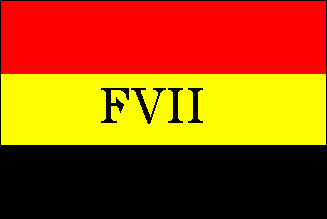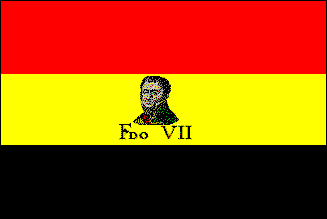
by Guillermo Aveledo , 3 October 1999

Last modified: 2003-11-08 by dov gutterman
Keywords: venezuela | miranda | caracas | cumana | costa firme |
Links: FOTW homepage |
search |
disclaimer and copyright |
write us |
mirrors
See:
See Also
Other Sites:
Flags of the Junta Defensora (or Conservadora) de los
Derechod de Fernando VII (Later Junta Revolucionaria), 1810.
After Napoleon's expansion to Spain, and the abrupt usurpation by
Jose Bonaparte of the Spanish crown, the Spanish Empire had,
suddenly, its head on the run. Trying to find a defense against
the usurpers, the people's of the Empire, alliances with
England were made. But, mainly, Juntas which invoked to
"Defend the Rights" of the Spanish king, Ferdinand VII
were established. This situation, so agobiating in the Kingdom,
was to be reflected all over the Empire. "Orphan and
desperate", the imperial nations, and their criollo
establishment, found a keen time for their autonomical
aspirations to come into reality. Around April of 1810, a French
Emmisary arrives to Caracas to ask the Captain General Emparan
and the Cabildo for their allegiance to King Jose Bonaparte. The
events unfolded nicely for the autonomical side, as, de facto,
the links with Spain were broken. The Caracas Junta, previous to
the declaration of Independnece (which did not occur on April
19th, 1810, but months later), adopted on May 3rd the flags of
these Juntas. Miranda's
tricolori was adopted on his arrival a year later. Description as
follows:

by Guillermo Aveledo , 3 October 1999
This flag, three equal stripes, had the same colours of the primitive Miranda's tricolori , but in the following order: red, yellow and black, with the king's initials on the yellow stripes (F-VII). The red and yellow stood for the Spanish Colours, common to all, and the black our alliance with England. This flag was also used as a cockade and an arm band among the revolutionaries.

by Guillermo Aveledo , 3 October 1999
Same as the previous flag, this one depicts an effigy or
portrait of the King Ferdinand VII (usually rendered handsomer
than he was; (I tried to remain faithful, but it was a very small
field.)"to whose freedom the combined efforts of both nation
and the general vows of the Americas are devoted".
Source: 1981 edition of